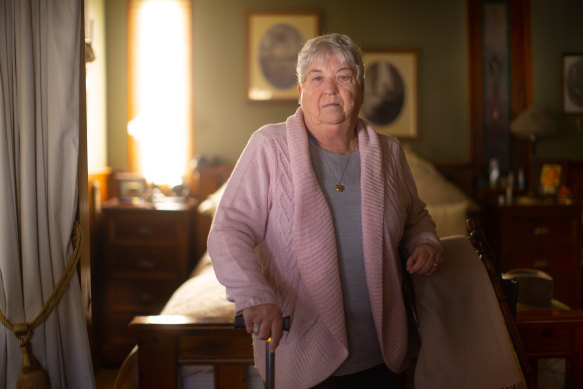Pam has waited 18 months for vital surgery. She now ‘lives on painkillers’

Save articles for later
Add articles to your saved list and come back to them any time.
Patients in regional Victoria are languishing in some emergency departments for twice as long as the statewide average, while others endure lengthy waits for elective surgery.
Doctor groups say the stark differences in care are due to inadequate staffing at some regional hospitals, resources failing to keep up with a growing population and patients delaying medical treatment due to GP shortages.
The latest health performance data from April to June reveals that patients at Ballarat Base Hospital, University Hospital Geelong, Latrobe Regional Hospital and Bendigo Hospital are waiting between 28 and 39 minutes to be treated in emergency departments compared with a statewide average of 17 minutes.
Australian Medical Association Victorian vice president Dr Simon Judkins, who works in northern Victoria, said hospital resources had not kept pace with growing regional populations.
“If you have an influx of patients and you only have two or three doctors, it takes a long time to get those patients in, seen and sorted because you don’t have the treatment areas and staff,” he said.
Rural Doctors Association of Victoria president Dr Dan Wilson said some patients were presenting at emergency departments after facing lengthy waits to see overwhelmed GPs.
“The only place to go when your condition is so significant that it is not suitable for primary care, is an emergency department,” Wilson said.
Regional and rural Victorians were more likely to have chronic diseases compared to their city counterparts, which placed additional pressures on the health system, he said.
Regional patients also face longer waits for the most urgent and least urgent elective surgeries.
Patients at Ballarat, Bendigo and Latrobe Hospitals wait an average of 14 days for the most urgent category 1 surgery, compared with a statewide average of 12 days.
While they have shorter waits for category 2 surgeries, patients at Bendigo, Shepparton and Geelong hospitals face waits of between 192 and 216 days for category 3 surgery, compared with the statewide average of 149 days.
Central Victorian pensioner Pat, who lives near Avoca in central Victoria, has been waiting for a knee replacement more than 18 months after receiving a referral to a surgeon.
She’s now experiencing extreme pain and relies on a walking stick.
“It’s completely debilitating because you lose your balance,” she said. “I live on painkillers.”
Central Victorian resident Pat says she is getting the runaround from health services.Credit: Simon Schluter
Pat saw a surgeon in May last year and was placed on a waiting list to have her surgery at Stawell hospital.
But after hearing nothing for months, she was contacted by the surgeon saying he was no longer operating at Stawell hospital, which merged with hospital services including Ballarat Health to form Grampians Health in October 2021.
Pat has resorted to taking out private health insurance and hopes to have her surgery in January.
Northern Grampians Shire Mayor Rob Haswell said other constituents had contacted him with similar experiences. But the exact duration of their wait times are unknown as elective surgery waitlist data is not collected for Stawell hospital.
At a council meeting earlier this month, Haswell moved a motion of no confidence in Grampians Health and accused it of eroding services after taking over the Stawell hospital.
In a statement on its website earlier this month, Grampians Health insisted Stawell hospital was still thriving and had not ceased surgeries. It said work was underway on a second operating theatre to double the surgical capacity of Stawell.
However, it confirmed it suspended the operating privileges of a visiting surgeon last year. It said all affected public patients were reassessed and reassigned a triage categorisation.
“We continue to work with patients to transfer their care to other surgeons,” it said.
A state government spokesperson said the latest health data showed that the surgery waitlist had dropped by 20 per cent since last year’s rollout of the $1.5 billion COVID catch up plan. They said every category 1 surgery was being carried out within the recommended time.
The spokesperson added that the government had recruited and trained more than 6000 healthcare workers, expanded the Victorian virtual emergency department and set up 27 primary care centres (a third of which are in regional Victoria) to alleviate pressure on hospitals.
“Work is underway to improve the recruitment, retention and supply of doctors across the public health sector, recognising this is a particular issue in regional and rural settings and hard to fill specialities,” he said.
Dr Steve Gourley, president-elect of the Australasian College for Emergency Medicine, said staffing issues were causing the deterioration of hospital care across regional Australia.
In Victoria, more than 200 health care workers resigned every week in 2020-21, with many burnt out from working through the pandemic.
“A lot of it boils down to making regional Australia more attractive, which might involve more financial incentives,” Gourley said.
Opposition health spokeswoman Georgie Crozier accused the government of failing to keep up with demand for regional health services.
“Every Victorian deserves the right to have basic health services close to home,” she said. “They’re not getting that at the moment because the health services aren’t there.”
Get the day’s breaking news, entertainment ideas and a long read to enjoy. Sign up to receive our Evening Edition newsletter here.
Most Viewed in National
From our partners
Source: Read Full Article

